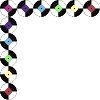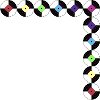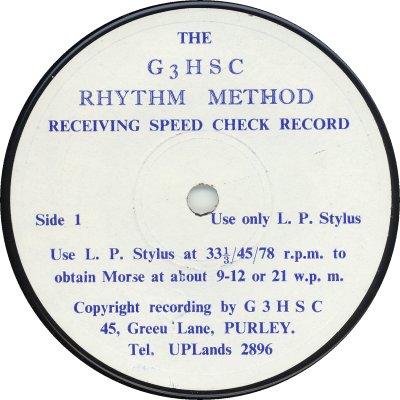
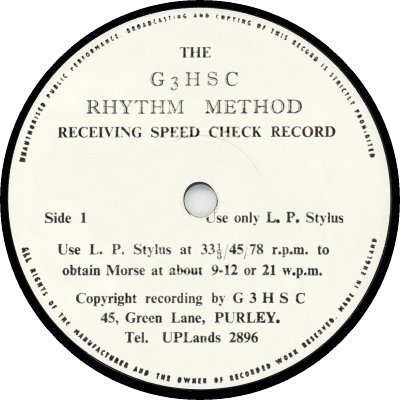
Debatable, this one, as G3HSC's only 7" record - an EP of Morse code signals - was first issued before the '70s. The EP was however re-pressed in the '70s through Lyntone and was sold in that decade, which gives the label at least a tenuous claim to a page on this site. According to issues of the Radio Amateur Callbook from the first half of the 1950s, G3HSC was the radio call sign of N. ('Stan') Bennett, of Plough Lane, Wallington, Surrey. By the time of the Autumn 1957 edition he had moved to Green Lane, Purley, and it is that address which appears on the labels of G3HSC's three records. As well as the EP there were two LPs - the 'Advanced Course' and the 'Beginners Course' - and they were all intended to be used by people who wanted to learn Morse code. By playing them at increasing speeds learners could gradually improve their skills of interpretation.
The records could be bought in various combinations, either on their own or accompanied by books. The earliest advert for them that I have been able to trace came in Short Wave magazine for January 1963, but they may have been on sale earlier. They proved popular, and they continued to feature in Amateur Radio enthusiasts' magazines throughout the '60s and '70s and into at least the early '80s - there was an advert for them in 'Radio Communication' magazine for November 1980, at which point they were available from RSGP Publications, of Doughty Street, London WC1N. At that time the 'Complete' package, which included all three records and some books, cost £6.45, while the 'Beginners' course - the appropriate LP, the EP and a book - could be had for £4.97. One LP and a book would set you back £4.29, while for the EP on its own you would have to fork out £2. In August 1966 the costs had been £4 4s for the 'Complete' package and £3 0s 6d for the 'Beginners'.
As it was available for a long time the EP was subject to various re-pressings, which led to variations in the appearance of the labels. What I assume is the earliest design (1) came in black-on-white and black-on-yellow as well as the blue-on-white shown, while what I assume is the later one had a typical set of 'prohibitions' around the rim (2) - thanks to Nicholas Hough for that scan. The Lyntone pressings had the matrix numbers LYN-3633 and LYN-3634, which enables us to pin them down to 1976. The EPs with blue-on-white labels had no run-off markings at all, if my copy is typical. See also 'Belding & Bennett', a custom recording label wich operated out of the same address.
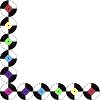
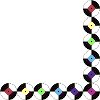
Copyright 2021 Robert Lyons.
